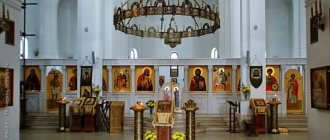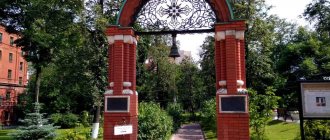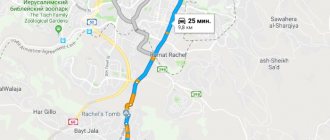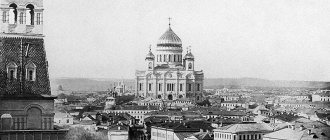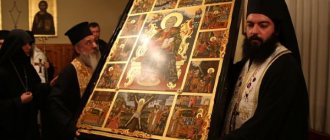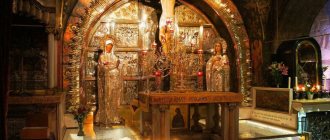Plan of Solomon's Temple in Jerusalem
Close to the Wall, you have to lift your head to see powerful rows of stones going up into the sky. They are chipped by winds, rains, and millennia. Below - polished by millions of touches, kisses of believers, thousands of notes with requests to God, stuck between stone blocks.
When Moses descended from Mount Sinai and the two tablets of revelation were in Moses’ hand as he descended from the mountain, Moses did not know that his face began to shine with rays because God spoke to him.
(Book of Exodus, chapter 34)
Since the ancestor of the Jewish people, the prophet Abraham , was given a promise from God, which said that Abraham would have descendants as countless as the “sand of the earth,” and this promise was sealed by a Covenant (agreement) with God, none of the children of Israel had the opportunity to speak with God . And only after Moses , who led his people out of Egyptian captivity, came to the Sinai desert, he received a revelation from God. Moses spent 40 days and 40 nights on Mount Sinai, after which he returned to the people and conveyed to them the 10 commandments inscribed on two stone tablets. God also commanded Moses, exactly as He described, to build the Tabernacle (Mishkan) - a portable temple in the form of a tent. The tabernacle, erected by Moses in one year, became the forerunner of the great Temple, but even this temporary structure was a more than impressive spectacle.
In the center of the huge courtyard, made of expensive fabrics hung from poles, there was a large tent, divided into two parts by a curtain. The first room was located opposite the entrance and was called the Holy Place. Here was the Altar of Burnt Offering, a golden Menorah - a seven-armed lamp and a table with ritual bread, on which lay 12 loaves (“showbread”), symbolizing the 12 tribes of Israel, that is, 12 generations. The second room, hidden by a curtain, was called the “Holy of Holies ,” inside which the Ark of the Covenant .
— Advertising —
When the Tabernacle was ready, Moses consecrated it with all its utensils with the holy ointment, and it became the House of the Lord on earth. Everything that was in the Tabernacle was filled with the deepest meaning. Its main treasure was the Ark of the Covenant, where two stone tablets of the Covenant were kept, given to Moses by God, a golden bowl with manna from heaven, which nourished the Jewish people during their forty-year wandering in the desert, as well as Aaron's rod , which blossomed as proof that it was his brother God chose Moses from the tribe (family) of Levi as high priest.
The Ark of the Covenant was made of acacia wood and trimmed with gold inside and out. At the bottom of each side of the Ark there were two rings so that poles could be inserted and thus carried during campaigns. The top of the Ark was closed with a massive lid (kaporet - purgatory). On top of the lid, facing each other, were installed two gold-cast Cherubim , overshadowing the Place of Forgiveness with their wings. Once a year, on the Day of Atonement, the high priest, and no one else, sprinkled the Place of Forgiveness with the blood of a sacrificial animal to atone for the sins of the entire people of Israel. It symbolized the visible throne of the invisible God and was the most sacred in the Tabernacle.
Construction of the first Jerusalem Temple
The First Sanctuary - the Tabernacle served the Jews for 480 years; in all their wanderings and campaigns, the Ark of the Covenant was with the people. A new page in the history of this shrine began at the end of the 11th century BC. reign of David . After 7 years, he set out with his army on a campaign to conquer the city of the Jebusites Irshal and make it the capital of the Kingdom of Judah. And although Irshalem, otherwise called the fortress of Zion, was considered an impregnable stronghold, David, through a vertical underground passage dug by the inhabitants in order to have a safe path to the only source of water in these places, together with his warriors entered the city and captured it.
The king named the city Jerusalem . David built a luxurious palace in it and carefully transferred the Ark of the Covenant to the new capital. And although King David himself was not given a blessing for the construction, he was told that the Temple would be built by his son Solomon , whose wise reign would not be stained by the blood shed in wars. Therefore, David erected only an altar on Mount Moriah. This mountain has been considered a sacred place by Jews since time immemorial. Noah made a sacrifice here after the Great Flood. Isaac here to sacrifice him, thereby proving his devotion to God.
And it was here in 967 BC. Solomon “began to build the house of the Lord in Jerusalem...” (2 Chronicles 3) according to a plan developed by his father together with the Supreme Court (Sanhedrin). The materials for the Temple were partly prepared by King David, and partly sent by King Hiram . Local sandstone, cypress and Lebanese cedar were used for construction - the most expensive material of that time, which was a symbol of power and might.
— Advertising —
7 years after the start of construction, the Temple was completed. Consecrating the Temple, King Solomon said something like the following: “This Temple will be holy for everyone, and a stranger, not from the people of Israel, will come to you” (1 Kings, 8). When the priests left the Sanctuary, a cloud filled the House of the Lord, for Shekinah (from Hebrew shakan - to dwell), symbolizing the visible presence of God among people, entered it. According to ancient Hebrew beliefs, God can materialize on Earth, this phenomenon is called the Glory of the Lord or Shekinah of Glory and occurs extremely rarely.
The Jerusalem Temple was not intended for prayer; the main action was a sacrifice designed to cleanse from sins. The construction of the Jerusalem Temple determined the significance of Jerusalem as an exceptional place, a place of attraction for the entire Jewish people. The ritual of sacrifice provided for the participation of all people in the worship service, not just priests. Any event occurring in the life of a Jew had to be accompanied by a sacrifice. This sacrifice was slaughtered in the Temple and its blood was sprinkled on the Altar, then everyone who brought the sacrifice had to take it for himself, roast it and eat it on the same day in Jerusalem at a festive meal with relatives and friends.
In addition, the Temple was also the main economic center of the Jewish state, since its repository was actually the state treasury. It was from the Temple treasury that funds were allocated for the annual repair and construction of roads. And since the private and public life of every Jew had to strictly comply with religious laws, the Temple was also the main center of the state judicial system.
Its importance in the life of the Jewish people can hardly be overestimated. The more terrible its destruction became. “In the fifth month, on the seventh day of the month, that is, in the nineteenth year of Nebuchadnezzar king of Babylon, Nebuzaradan the captain of the guard, the servant of the king of Babylon, came to Jerusalem and burned the house of the Lord and the king’s house, and all the houses in Jerusalem, and all the great houses. burned with fire, and the walls around Jerusalem were destroyed by the army of the Chaldeans who were the captain of the guard” (2 Kings 25:8-10). Thus the prophecy came true that God would punish the Jewish people for their depravity and lawlessness.
Purposes of processing personal data
3.1. The operator processes personal data for the following purposes:
3.1.1. for the execution of a contract to which the subject of personal data is a party;
3.1.2. establishing feedback for processing incoming requests from individuals for the purpose of providing information and consulting services, advertising services, including sending notifications and requests;
3.1.3. to promote the Operator’s information services on the market by making direct contacts with the subject of personal data using communication means;
3.1.4. conducting personnel work and organizing records of the Operator’s employees;
3.1.5. attracting and selecting candidates to work for the Operator;
3.1.6. identification of a visitor to the Operator’s website - https://undergroundexpert.info/;
3.1.7. providing website visitors with information about the company and the services provided;
3.1.8. to achieve the goals provided for by an international treaty of the Russian Federation or law, to implement and fulfill the functions, powers and responsibilities assigned by the legislation of the Russian Federation to the Operator;
Destruction of the Jerusalem Temple
Punishment came in the person of the Babylonian king Nebuchadnezzar II , who in the 19th year of his reign, that is, in 586 BC, captured Jerusalem and burned Solomon's Temple . Most of the inhabitants of Jerusalem were killed, the rest were taken captive and driven into slavery in Babylon.
— Advertising —
The Babylonian slavery of the Jewish people, sent to them by God to atone for their sins, lasted for many years, during which they were excommunicated from the Promised Land and from the ruins of the sacred Temple. But during the years of the Babylonian captivity, in which the prophet Ezekiel , he had a vision from God, in which he saw in detail the new Temple, standing in the same place as the Temple of Solomon.
And only in 538 BC. With the permission of the Persian king Cyrus , who conquered Babylonia, the first settlers, led by the elder Zerubbabel, . In the second year after returning from Babylon, construction of the Temple began, and in 516 it was finally erected. 70 years after the destruction of Solomon's Temple.
Present tense
Now the site of Solomon's Temple is home to the Dome of the Rock and the Al Aqsa Mosque. After Herod's Temple, two ruins remained - the southern part of the western wall, which is better known as the "Wailing Wall" and the "Golden Gate", which were previously the entrance arches in the eastern wall.
The temple stands on the site of the Mosque of Omar (Dome of the Rock). In the middle of the Dome of the Rock there is a rock 1.25-2 meters high and 18 meters long and 14 meters wide. The stone is considered sacred; it is surrounded by a gilded lattice, which protects it from attacks.
There are other options for the location of the Temple. 20 years ago, Israeli physicist Asher Kaufman made the assumption that both the First and Second Temples were located north of the Rock Mosque. According to his assumptions, the Holy of Holies and the Foundation Stone are located under today's "Dome of the Spirits", a small medieval building.
Second Temple of Jerusalem
The Second Temple of Jerusalem was not as impressive and magnificent as the First. It must also be said that there was no longer the Ark of the Covenant in the Second Temple. According to legend, after the destruction of the Temple he was taken to Babylon, but his exact fate is not known.
In the long history of the Second Temple of Jerusalem, everything happened. During the time of the Syrian king Antiochus Epiphanes IV (175–164 BC), under whose control Judea was at that time, the Temple was desecrated and services in it were suspended. But in 164 BC. After the Maccabean , the Temple was cleansed of defilement, renovated, and the lighting of the Menorah was resumed. From then on, the Jewish holiday Hanukkah was established, dedicated to the cleansing of the Temple.
The Second Temple reached its greatest prosperity during the reign of King Herod the Great , at the end of the 1st century BC. it was almost completely rebuilt, so that almost nothing remained of the former Temple built by Zerubbabel. But it continued to be called the Second Temple. The rebuilt Temple stood on a white marble plinth with a staircase in front of the main entrance. The Holy Place contained a lampstand, a table for the Showbread, and an Altar.
The Jewish War of 66-73 played a fatal role in the history of the Temple, which humbled the pride of the Jews disobedient to Rome . The 70th was the year of the fall of Jerusalem and the year of the destruction of the Second Temple of Jerusalem. On August 9 (9th of Av according to the Jewish calendar), the same day that the Babylonians set fire to Solomon's Temple, the Second Temple also went up in flames.
It burned for 10 days, and by September all of Jerusalem was reduced to ruins and the Temple Mount was plowed open. Almost 100,000 inhabitants were captured, and those who died from the sword, hunger and other captives during the war, according to Josephus, numbered about 1 million 100 thousand people. were sent to Rome by order of Emperor Titus The destruction of Jerusalem and the burning of the Temple marked the beginning of the dispersion of Jews throughout the world.
Transfer of personal data to third parties
7.1. To achieve the purposes of processing personal data and with the consent of the subjects of personal data, the Operator provides personal data or entrusts their processing to the following persons:
7.1.1. government agencies;
7.1.2. individuals who are in labor and civil relations with the Operator's counterparties;
7.1.3. to individuals who are in labor and civil legal relations with the Operator.
7.2. In order to fulfill contractual obligations or requirements of federal law, the Operator receives personal data from the following third parties:
7.2.1. Other persons in accordance with a civil law agreement.
7.3. The processing of personal data is carried out in compliance with confidentiality, which means the obligation not to disclose to third parties or distribute personal data without the consent of the subject of personal data, unless otherwise provided by the legislation of the Russian Federation.
Attempts to revive the Temple of the Lord
66 years later, the Roman Emperor Hadrian, in the colony of Elia Capitolina built on the ruins of Jerusalem on the sacred mountain, installed the temple of Jupiter and his own statue, facing east.
All further attempts of the Jews to revive the Temple of the Lord failed. Even the official permission of Emperor Julian the Apostate , given for the construction of a new Temple in 362, could not change its predetermined fate - earthquakes and fires mercilessly destroyed the work of its builders... Fire safety certification
So the Jews lost their shrine, the place where the House of the Lord was on Earth. The first time they were punished for the sins of idolatry, incest and bloodshed, the second time - for causeless internecine enmity.
Talmudic tradition says that when the Temple was destroyed, all of Heaven's Gates except one, the Gate of Tears, were closed, and the Western Wall , remaining from the Second Temple of Jerusalem, was called the Wailing Wall , since the tears of all Jews mourning their Temple are shed here.


